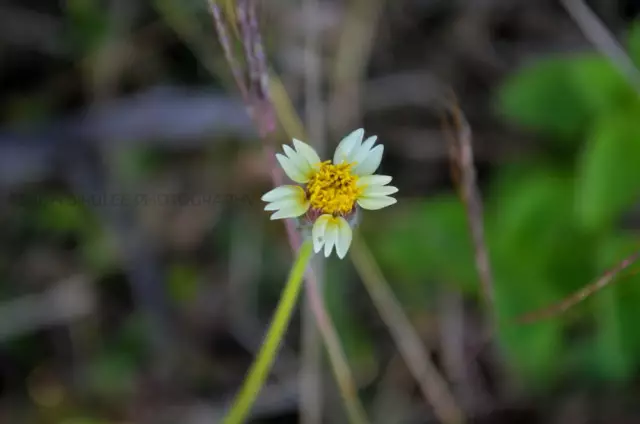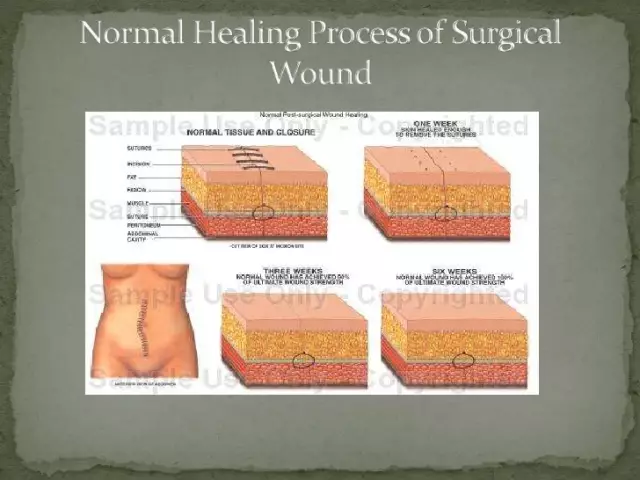- Author Curtis Blomfield [email protected].
- Public 2023-12-16 20:44.
- Last modified 2025-01-23 17:01.
A wound is mechanical damage to tissues in the presence of violations of the integrity of the skin. The presence of a wound, rather than a bruise or hematoma, can be determined by signs such as pain, gaping, bleeding, impaired function and integrity. PST of the wound is carried out in the first 72 hours after the injury, if there are no contraindications.
Varieties of wounds
Each wound has a cavity, walls and bottom. Depending on the nature of the damage, all wounds are divided into stab, cut, chopped, bruised, bitten and poisoned. During the PST of the wound, this must be taken into account. After all, the characteristics of first aid depend on the nature of the injury.
- Stab wounds are always caused by a piercing object, such as a needle. A distinctive feature of the damage is a great depth, but small damage to the integument. In view of this, it is necessary to make sure that there is no damage to blood vessels, organs or nerves. Stab wounds are dangerous due to mild symptoms. So if there is a wound on the abdomen, there is a possibility of liver damage. This is not always easy to see during PST.
- Incised woundapplied with a sharp object, so tissue damage is small. At the same time, the gaping cavity is easy to inspect and perform PST. Such wounds are well treated, and healing is carried out quickly, without complications.
- Chop wounds are caused by injury with a sharp but heavy object, such as an axe. In this case, the damage differs in depth, the presence of a wide gaping and bruising of neighboring tissues is characteristic. Because of this, the ability to regenerate is reduced.
- Bruised wounds appear when using a blunt object. These injuries are characterized by the presence of many damaged tissues heavily saturated with blood. When conducting PST of a wound, it should be taken into account that there is a possibility of suppuration.
- Bite wounds are dangerous because of the penetration of infection with the saliva of an animal, and sometimes a person. There is a risk of developing an acute infection and the emergence of the rabies virus.
- Poison wounds are usually caused by snake or spider bites.
- Gunshot wounds differ in the type of weapon used, the characteristics of the damage and the trajectories of penetration. High chance of infection.
When conducting PST of a wound, the presence of suppuration plays an important role. Such injuries are purulent, freshly infected and aseptic.

Purpose of PST
Primary surgical debridement is necessary to remove harmful microorganisms that have entered the wound. For this, all damaged dead tissues, as well as blood clots, are cut off. Thereafter, sutures are placed anddrainage is performed if necessary.
The procedure is needed in the presence of tissue damage with uneven edges. Deep and contaminated wounds require the same. The presence of damage to large blood vessels, and sometimes bones and nerves, also requires surgical work. PHO is carried out simultaneously and exhaustively. The assistance of a surgeon is necessary for the patient for up to 72 hours after the wound has been inflicted. Early PST is performed during the first day, the second day is a delayed surgical intervention.

Pho tools
At least two copies of the kit are required for the initial wound treatment procedure. They are changed during the operation, and after the dirty stage they are disposed of:
- Clamp "Korntsang" straight, which processes the surgical field;
- scalpel pointed, abdominal;
- linen claws are used to hold dressings and other materials;
- Kocher, Billroth and mosquito clamps are used to stop bleeding, they are used in large quantities during PST;
- scissors, they are straight, as well as curved along a plane or edge in several copies;
- Kocher probes, grooved and bellied;
- needle set;
- needle holder;
- tweezers;
- hooks (several pairs).
The surgical kit for this procedure also includes suture material, injection needles, syringes, bandages, gauze balls, rubber gloves, all kinds of tubes andnapkins. All items that will be needed for PST - suture and dressing kits, instruments and drugs intended for wound treatment - are laid out on the surgical table.

Essential Medicines
Primary surgical treatment of a wound is not complete without special medicines. The most commonly used are:
- 70% alcohol;
- 3% hydrogen peroxide solution;
- 1% solution of iodopyrone or 0.5% solution of chlorhexidine bigluconate;
- 10% NaCl solution;
- 0.25% - 0.5% novocaine solution.

PHO stages
Primary surgical treatment is carried out in several stages:
- Examination of the wound with its subsequent treatment with an antiseptic.
- Removal of damaged tissues, foreign bodies, bone fragments. The wound is incised as needed.
- Stop bleeding.
- Drainage.
- Suturing.

How PHO is done
For surgery, the patient is placed on the table. Its position depends on the location of the wound. The surgeon must be comfortable. The wound is toileted, the operating field is processed, which is delimited by sterile disposable underwear. Next, the primary intention is performed, aimed at healing existing wounds, and anesthesia is administered. In most cases, surgeons use the Vishnevsky method - they inject 0.5%solution of novocaine at a distance of two centimeters from the edge of the cut. The same amount of solution is injected from the other side. With the correct reaction of the patient, a "lemon peel" is observed on the skin around the wound. Gunshot wounds often require the patient to be given general anesthesia.
The edges of damage up to 1 cm are held with a Kochcher clamp and cut off in a single block. When performing the procedure, non-viable tissue is cut off on the face or fingers, after which a tight suture is applied. Gloves and tools are being replaced.
The wound is washed with chlorhexidine and examined. Stab wounds with small but deep incisions are dissected. If the edges of the muscles are damaged, they are removed. Do the same with bone fragments. Next, hemostasis is performed. The inside of the wound is treated first with a solution and then with antiseptic preparations.
The treated wound without signs of sepsis is sutured tightly with a primary manual suture and covered with an aseptic bandage. Seams are performed, evenly capturing all layers in width and depth. It is necessary that they touch each other, but do not pull together. When performing work, it is necessary to receive a cosmetic suture after healing.
In some cases, primary sutures are not applied. A cut wound can be more serious than it seems at first glance. If the surgeon is in doubt, a primary delayed suture is used. This method is used if the wound has been infected. Suturing is carried out to fatty tissue, and the seams do not tighten. A few days after observation, the wound is suturedto the end.

Bite wounds
PHO wound, bitten or poisoned, has its own differences. When bitten by non-venomous animals, there is a high risk of contracting rabies. At an early stage, the disease is suppressed by anti-rabies serum. Such wounds in most cases become purulent, so they try to delay the PHO. During the procedure, a primary delayed suture is applied and antiseptic drugs are applied.
A snake bite wound requires a tight tourniquet or bandage. In addition, the wound is frozen with novocaine or cold is applied. Anti-snake serum is injected to neutralize the venom. Spider bites are blocked by potassium permanganate. Before that, the poison is squeezed out, and the wound is treated with an antiseptic.

Complications
Poor treatment of the wound with antiseptics leads to suppuration of the wound. Improper anesthetic, as well as causing additional injuries, causes anxiety in the patient due to the presence of pain.
Rough attitude to tissues, poor knowledge of anatomy lead to damage to large vessels, internal organs and nerve endings. Insufficient hemostasis causes inflammation.
It is very important that the primary surgical treatment of the wound is carried out by a specialist in all the rules.






